The Satellite-based 5G Network Market is estimated to be valued at USD 1.7 billion in 2025 and is projected to reach USD 99.3 billion by 2035, registering a compound annual growth rate (CAGR) of 50.0% over the forecast period. This exponential trajectory highlights how satellite integration into 5G is set to transform global connectivity, bridging gaps where terrestrial networks remain limited. During the early adoption phase (2020–2024), the market grew modestly from USD 0.2 billion to 1.1 billion as proof-of-concept deployments and pilot programs validated the feasibility of non-terrestrial networks (NTN). This stage was marked by collaboration between satellite operators and telecom providers, aimed at testing standards, reducing latency, and ensuring seamless interoperability with terrestrial 5G systems.
The scaling phase (2025 & 2030) accelerates growth, with the market expanding rapidly from USD 1.7 billion to nearly USD 19.6 billion by 2030. Demand is driven by increasing reliance on satellite-based 5G for rural, maritime, aviation, and defense applications. Technological advancements in LEO satellite constellations, cost-efficient launches, and integrated spectrum use make satellite 5G more commercially viable and widely adopted. By the consolidation phase (2030–2035), the market stabilizes as it reaches USD 99.3 billion. Industry leaders consolidate through alliances and vertical-specific solutions, while innovation focuses on global coverage, AI-optimized traffic management, and ultra-reliable low-latency communications, establishing satellite 5G as a mainstream enabler of universal connectivity.
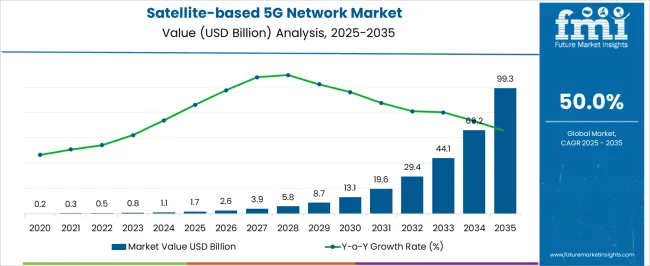
| Metric | Value |
|---|---|
| Satellite-based 5G Network Market Estimated Value in (2025 E) | USD 1.7 billion |
| Satellite-based 5G Network Market Forecast Value in (2035 F) | USD 99.3 billion |
| Forecast CAGR (2025 to 2035) | 50.0% |
The satellite-based 5G network market is progressing rapidly, driven by the growing need for reliable high-speed internet access in underserved and remote areas. Advances in satellite technology have expanded the capacity and coverage of communication networks, enabling more consistent 5G service beyond traditional terrestrial infrastructure. Industry developments have highlighted how low Earth orbit satellite constellations improve latency and bandwidth, making satellite 5G increasingly competitive.
The demand for connectivity in rural locations, maritime, and aviation sectors has boosted market adoption. Regulatory support and investments in space infrastructure have further encouraged satellite network deployment. Future growth is expected to be influenced by enhancements in frequency band utilization and integration with terrestrial 5G networks.
Segmental growth is expected to be driven by low Earth orbit satellites for their proximity and responsiveness, Ku-band frequencies for optimal signal quality, and consumer broadband applications targeting residential users in hard-to-reach regions.
The satellite-based 5G network market is segmented by satellite type, frequency band, application, component, end user, and geographic regions. By satellite type, the satellite-based 5G network market is divided into Low Earth Orbit (LEO) satellites, Medium Earth Orbit (MEO) satellites, Geostationary Orbit (GEO) satellites, and Others. In terms of frequency band, the satellite-based 5G network market is classified into Ku-band, Ka-band, C-band, and Others (L-Band, S-Band).
Based on application, the satellite-based 5G network market is segmented into Consumer broadband, Enterprise broadband, and Public. By component, the satellite-based 5G network market is segmented into Hardware, Software, and Services. By end user, the satellite-based 5G network market is segmented into Telecommunications companies, Government agencies, Maritime and aviation, Transportation and logistics, Industrial, and Others. Regionally, the satellite-based 5G network industry is classified into North America, Latin America, Western Europe, Eastern Europe, Balkan & Baltic Countries, Russia & Belarus, Central Asia, East Asia, South Asia & Pacific, and the Middle East & Africa.
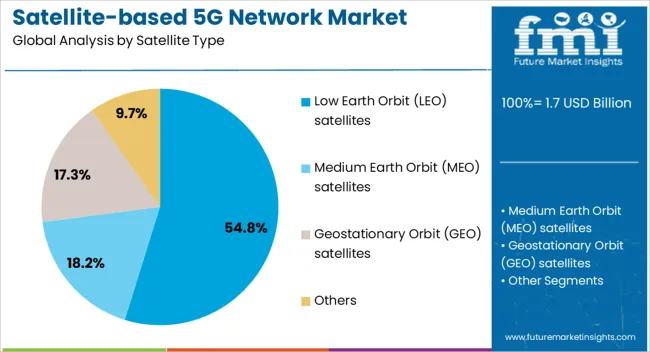
The Low Earth Orbit satellites segment is projected to hold 54.8% of the market revenue in 2025, leading the satellite type category. This segment's expansion is driven by the advantage LEO satellites offer in reduced signal latency compared to higher orbit satellites. The closer proximity to Earth enables faster data transmission and improved responsiveness for 5G applications.
Additionally, the deployment of large constellations of LEO satellites allows for broader coverage and higher throughput. Operators and network planners favor LEO satellites as they can better support the dynamic bandwidth demands of modern 5G networks. Their ability to complement terrestrial infrastructure makes them an essential component in achieving global 5G connectivity goals.
As satellite manufacturing and launch costs decline, LEO satellites are expected to continue dominating this market segment.
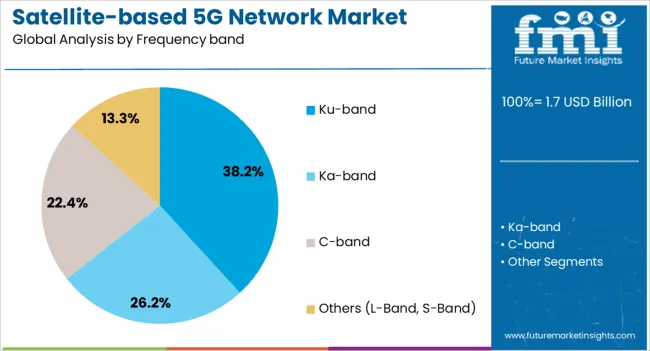
The Ku-band segment is expected to account for 38.2% of the satellite-based 5G network market revenue in 2025, securing its place as the leading frequency band. The Ku-band offers a good balance between bandwidth capacity and atmospheric penetration, making it suitable for 5G communication. Its widespread adoption is attributed to the availability of existing satellite infrastructure and equipment compatibility.
The band supports high data throughput and is less susceptible to rain fade compared to higher frequency bands, which is vital for maintaining reliable connections. Network operators have leveraged Ku-band frequencies to optimize satellite link performance for consumer and enterprise applications.
As technology advances, enhancements in modulation and coding techniques are anticipated to further improve Ku-band efficiency. This segment is expected to maintain its importance in satellite 5G deployments due to its operational advantages and established ecosystem.
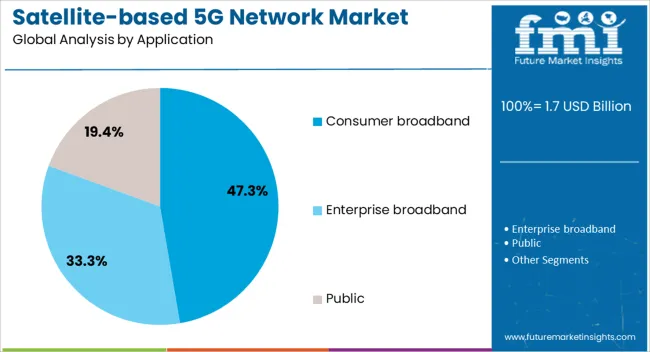
The Consumer Broadband segment is projected to contribute 47.3% of the market revenue in 2025, holding the largest share among applications. Growth in this segment has been propelled by rising demand for high-speed internet access in remote and rural areas where terrestrial 5G coverage is limited. Consumers increasingly require reliable broadband for streaming, telecommuting, and online education, creating a strong market for satellite-based 5G services.
Satellite networks enable service providers to offer broadband connectivity without the need for extensive ground infrastructure, reducing deployment time and costs. Moreover, the expansion of smart home devices and connected entertainment systems has fueled broadband demand.
As satellite technology continues to improve latency and throughput, consumer broadband is expected to remain a major driver of satellite 5G network market growth, bridging connectivity gaps worldwide.
The satellite-based 5G network market is gaining momentum as telecom providers, governments, and private players invest in extending high-speed connectivity to underserved and remote areas. Integration of satellite infrastructure with terrestrial 5G networks supports seamless coverage, low-latency applications, and IoT expansion. Demand is driven by defense, maritime, aviation, and rural broadband initiatives. Strategic collaborations between satellite operators and telecom companies, along with advancements in network architecture, fuel adoption, while cost, bandwidth, and regulatory complexities remain important considerations.
Satellite-based 5G networks are being deployed to bridge connectivity gaps in regions lacking terrestrial infrastructure. Remote areas, islands, offshore platforms, and rural communities benefit from these solutions, as satellites deliver reliable high-speed internet where traditional networks are not feasible. Governments worldwide are prioritizing rural broadband access, often subsidizing projects that include satellite integration. This expansion is critical for digital inclusion, enabling education, telemedicine, and e-commerce in underserved regions. The growing reliance on always-on connectivity ensures strong long-term demand for satellite-based 5G services.
Telecom companies and satellite providers are increasingly entering into partnerships to accelerate satellite-based 5G deployment. These collaborations allow terrestrial and non-terrestrial networks to function seamlessly, offering users consistent coverage across geographies. Joint ventures provide access to shared spectrum, infrastructure expertise, and reduced capital risks. Equipment manufacturers also contribute to ecosystem development by designing devices compatible with hybrid 5G connectivity. Partnerships improve rollout timelines, reduce duplication of efforts, and foster innovation in service delivery. As competition intensifies, such alliances become critical to maintaining market leadership in this emerging segment.
Satellite-based 5G networks rely on low earth orbit (LEO) constellations, advanced ground stations, and improved spectrum management to achieve low-latency and high-throughput performance. Integration with cloud-based orchestration and software-defined networking ensures efficient traffic routing and service quality. These advancements support real-time applications such as autonomous systems, remote monitoring, and streaming in remote environments. Improved performance capabilities expand potential use cases, from defense and maritime industries to smart agriculture and global logistics. The continuous refinement of network architecture positions satellite-based 5G as a competitive alternative to terrestrial solutions.
Despite strong growth, the satellite-based 5G network market faces challenges related to high capital investment, limited bandwidth availability, and regulatory hurdles. Launching satellite constellations requires significant upfront costs, making large-scale deployments feasible only for major players or government-backed initiatives. Bandwidth allocation remains limited and subject to international coordination, which can delay projects. Regulatory approvals vary by region, complicating global standardization. Additionally, competition with terrestrial 5G solutions in urban areas reduces market scope. Overcoming these challenges will require strategic funding, government cooperation, and efficient spectrum management.
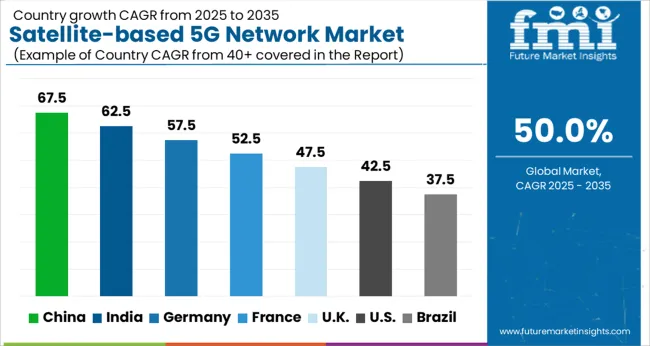
The global satellite-based 5G network market is projected to expand at a remarkable CAGR of 50.0%, driven by the demand for seamless connectivity and low-latency communication across remote and underserved regions. China leads the market with a 67.5% growth rate, propelled by aggressive investments in satellite constellations and next-generation communication projects. India follows at 62.5%, supported by initiatives to bridge rural connectivity gaps and enhance broadband penetration. Germany demonstrates strong momentum at 57.5%, reflecting the country’s focus on integrating satellite links into advanced communication networks. The UK and USA register significant growth rates of 47.5% and 42.5%, respectively, highlighting ongoing projects to expand 5G coverage beyond urban areas. This report includes insights on 40+ countries; the top countries are shown here for reference.
China leads the Satellite-based 5G Network Market with a CAGR of 67.5%, supported by large-scale government investments in space technology and digital infrastructure. The country’s aggressive rollout of 5G networks, combined with satellite connectivity, enables high-speed internet access in remote and rural areas. Integration of satellite-based communication with terrestrial 5G enhances coverage, network reliability, and data capacity. China’s focus on developing indigenous satellite constellations strengthens its dominance in the global market. Strategic collaborations with telecom operators, technology providers, and aerospace firms accelerate adoption. Furthermore, initiatives aligned with smart cities, IoT, and autonomous vehicles fuel demand for advanced connectivity. Growing consumer demand for seamless mobile broadband and enterprise reliance on low-latency networks further drive expansion. China’s comprehensive ecosystem of satellite manufacturing, 5G deployment, and innovation ensures strong long-term growth.
Satellite-based 5G Network Market in India is expanding at a remarkable CAGR of 62.5%, fueled by initiatives to bridge the digital divide across rural and underserved regions. Government-backed digital transformation projects and partnerships with global satellite communication providers are central to growth. India emphasizes hybrid connectivity models combining terrestrial 5G with satellite communication to ensure uninterrupted coverage. The rise of smart devices, e-governance applications, and IoT-based rural solutions accelerates adoption. The market benefits from affordable satellite services aimed at enhancing education, healthcare, and financial inclusion. Telecom operators are collaborating with satellite technology providers to expand reach and improve capacity. India’s growing digital economy and increasing demand for high-speed internet services in both urban and rural areas will ensure sustained growth in satellite-based 5G networks over the forecast period.
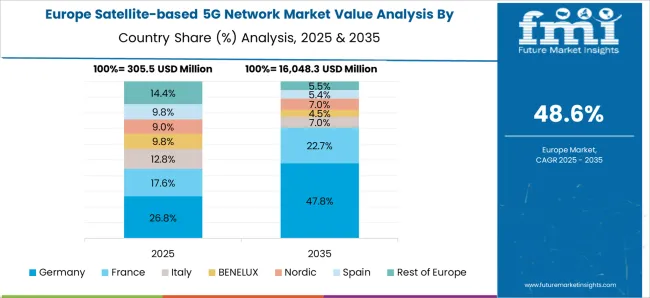
Germany’s Satellite-based 5G Network Market grows at 57.5%, supported by strong demand for uninterrupted connectivity across industries. The integration of satellite communication with terrestrial 5G enables reliable coverage in remote, rural, and industrial regions. Germany’s focus on Industry 4.0, autonomous mobility, and IoT applications necessitates high-speed and low-latency networks. Government programs encourage investment in digital infrastructure and advanced communication technologies. Partnerships between aerospace firms, telecom operators, and technology providers enhance adoption. The market benefits from demand in logistics, transportation, and manufacturing sectors where seamless connectivity is essential. Energy-efficient satellite solutions and increasing reliance on smart city applications are also significant growth drivers. Germany’s emphasis on sustainability and innovation ensures robust long-term expansion of the satellite-based 5G ecosystem.
The UK market expands at 47.5%, supported by growing demand for advanced communication solutions across urban and rural regions. Government-backed space and telecom initiatives focus on integrating satellites with 5G networks to enhance nationwide coverage. The UK’s emphasis on resilient, secure, and low-latency communication infrastructure benefits defense, logistics, and public services. Telecom operators collaborate with satellite providers to extend connectivity in remote areas. Growth in smart city initiatives, autonomous vehicles, and IoT ecosystems contributes to strong demand. Energy-efficient and sustainable satellite technologies are gaining importance as part of the UK’s net-zero strategy. Increasing digital transformation in both public and private sectors ensures continued adoption of satellite-based 5G solutions, strengthening the UK’s position in the global market.
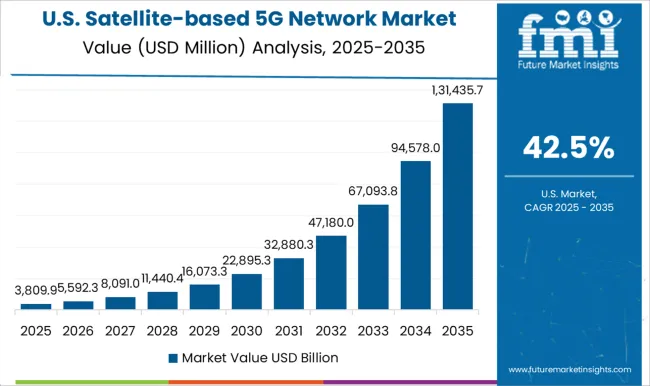
The USA market grows at 42.5%, driven by rising demand for high-speed, low-latency connectivity in defense, aerospace, and commercial sectors. Leading private players such as SpaceX and Amazon are heavily investing in satellite constellations to complement terrestrial 5G networks. Government projects and military applications further strengthen adoption of satellite-based communication. The USA emphasizes bridging digital gaps in underserved rural areas through hybrid connectivity models. Expanding IoT applications, autonomous transportation, and industrial automation demand advanced connectivity solutions. Energy-efficient satellite technologies aligned with sustainability goals enhance long-term adoption. Collaborations between telecom operators and satellite providers ensure widespread deployment. With its innovation-driven ecosystem and global leadership in space technologies, the USA remains a critical market for satellite-based 5G expansion.
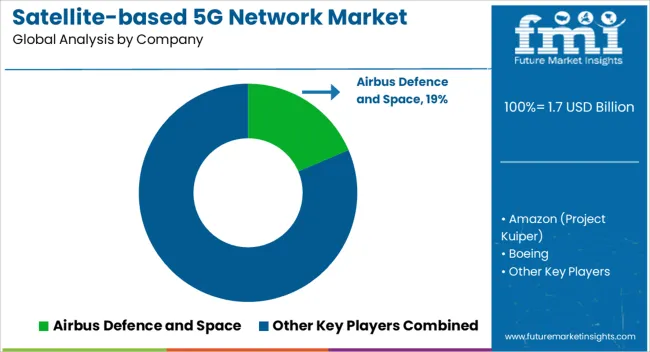
Airbus Defence and Space and Lockheed Martin are leading players, leveraging their expertise in aerospace and defense technologies to develop advanced satellite-based 5G solutions. Boeing and Northrop Grumman contribute innovative satellite systems and integration capabilities that support next-generation communication infrastructure. Amazon (Project Kuiper) is investing heavily in satellite constellations to expand broadband services and extend 5G coverage globally, competing with other large-scale satellite operators. EchoStar Corporation and Globalstar, Inc. play critical roles in providing satellite-based broadband and mobile satellite services, supporting the evolution of hybrid 5G connectivity. Eutelsat Communications continues to expand its satellite fleet, focusing on delivering high-capacity solutions tailored for telecom operators and enterprises seeking to leverage 5G capabilities. The market outlook is highly promising, with governments, telecom providers, and private enterprises collaborating to develop integrated satellite-terrestrial 5G networks. As low-earth orbit (LEO) constellations and advanced satellite technologies mature, satellite-based 5G will become a cornerstone for global connectivity, ensuring reliable and secure communication in even the most remote geographies.
| Item | Value |
|---|---|
| Quantitative Units | USD 1.7 Billion |
| Satellite Type | Low Earth Orbit (LEO) satellites, Medium Earth Orbit (MEO) satellites, Geostationary Orbit (GEO) satellites, and Others |
| Frequency band | Ku-band, Ka-band, C-band, and Others (L-Band, S-Band) |
| Application | Consumer broadband, Enterprise broadband, and Public |
| Component | Hardware, Software, and Services |
| End User | Telecommunications companies, Government agencies, Maritime and aviation, Transportation and logistics, Industrial, and Others |
| Regions Covered | North America, Europe, Asia-Pacific, Latin America, Middle East & Africa |
| Country Covered | United States, Canada, Germany, France, United Kingdom, China, Japan, India, Brazil, South Africa |
| Key Companies Profiled | Airbus Defence and Space, Amazon (Project Kuiper), Boeing, EchoStar Corporation, Eutelsat Communications, Globalstar, Inc., Lockheed Martin, and Northrop Grumman |
| Additional Attributes | Dollar sales by component including satellites, ground stations, and network equipment, application across defense, aerospace, maritime, and remote communications, and region covering North America, Europe, and Asia-Pacific. Growth is driven by rising demand for global connectivity, expansion of 5G infrastructure, and increasing use of satellite communication in underserved regions. |
The global satellite-based 5G network market is estimated to be valued at USD 1.7 billion in 2025.
The market size for the satellite-based 5G network market is projected to reach USD 99.3 billion by 2035.
The satellite-based 5G network market is expected to grow at a 50.0% CAGR between 2025 and 2035.
The key product types in satellite-based 5G network market are low earth orbit (leo) satellites, medium earth orbit (meo) satellites, geostationary orbit (geo) satellites and others.
In terms of frequency band, ku-band segment to command 38.2% share in the satellite-based 5G network market in 2025.






Full Research Suite comprises of:
Market outlook & trends analysis
Interviews & case studies
Strategic recommendations
Vendor profiles & capabilities analysis
5-year forecasts
8 regions and 60+ country-level data splits
Market segment data splits
12 months of continuous data updates
DELIVERED AS:
PDF EXCEL ONLINE
5G Millimeter Wave RF Transceiver Market Size and Share Forecast Outlook 2025 to 2035
5G Testing Market Size and Share Forecast Outlook 2025 to 2035
5G in Healthcare Market Analysis Size and Share Forecast Outlook 2025 to 2035
5G Temperature-Compensated Crystal Oscillator (TCXO) Market Size and Share Forecast Outlook 2025 to 2035
5G Remote Surgery System Market Analysis - Size, Share, and Forecast Outlook 2025 to 2035
5G Telemedicine Platform Market Size and Share Forecast Outlook 2025 to 2035
5G Industrial IOT Market Size and Share Forecast Outlook 2025 to 2035
5G IoT Market Size and Share Forecast Outlook 2025 to 2035
5G in Defense Market Size and Share Forecast Outlook 2025 to 2035
5G Automotive Grade Product Market Size and Share Forecast Outlook 2025 to 2035
5G Enterprise Market Size and Share Forecast Outlook 2025 to 2035
5G Infrastructure Market Size and Share Forecast Outlook 2025 to 2035
5G RAN Market Size and Share Forecast Outlook 2025 to 2035
5G Security Market Size and Share Forecast Outlook 2025 to 2035
5G Testing Equipment Market Analysis - Size, Growth, and Forecast 2025 to 2035
5G technology market Analysis by Technology Type, Application, Vertical, and Region – Growth, trends and forecast from 2025 to 2035
5G in Automotive and Smart Transportation Market by Solution ,Application,Industry , Warehousing & Logistics, Warehousing & Logistics, Public Safety and Others & Region Forecast till 2025 to 2035
5G System Integration Market Insights - Demand & Growth Forecast 2025 to 2035
5G Chipset Market Analysis - Growth & Forecast through 2034
5G Fixed Wireless Access Market

Thank you!
You will receive an email from our Business Development Manager. Please be sure to check your SPAM/JUNK folder too.
Chat With
MaRIA